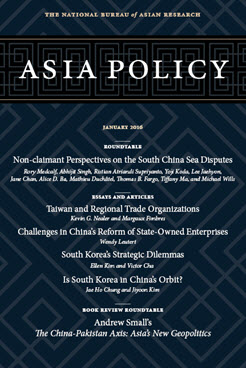ASEAN's Stakes
The South China Sea's Challenge to Autonomy and Agency
This essay is part of the roundtable “Non-claimant Perspectives on the South China Sea Disputes.”
The South China Sea has come to involve important stakes for all involved. The Association of Southeast Asian Nations (ASEAN) is no different—though its situation is also notably distinct. The South China Sea occupies what Michael Leifer once characterized as the geographic “heart of Southeast Asia.” [1] Geography alone means that whatever happens in the South China Sea affects ASEAN states the most directly. Moreover, as smaller powers, these states confront much greater vulnerabilities when it comes to great-power demands, even as they may be particular beneficiaries of great-power association. China’s activities in the South China Sea have no doubt underscored these dilemmas as the ASEAN states all try to navigate between the strategic vulnerabilities and the economic opportunities associated with a rising, more confident China. Nor are ASEAN states’ great-power dilemmas limited to China: the latter’s activities in the South China Sea have also precipitated heightened attention from the United States. ASEAN’s challenge is thus compounded by the fact that the South China Sea has become an important focal point of rivalry and tension between the ASEAN region’s two most important great-power relationships. Maintaining a space between China and the United States—one in which Southeast Asian states can enjoy some range of maneuver and choice—may prove to be the greatest challenge confronting the ASEAN region.
This essay considers what is at stake in the South China Sea disputes for ASEAN’s coalition of smaller powers, with special attention paid to institutional interests and constraints. It considers not only the more immediate challenges created by territorial disputes but also the more general great-power dilemmas that heightened tensions have recently thrown into sharp relief.
ASEAN’s Immediate Challenges
Most immediately, China’s physical and jurisdictional assertions create the challenge for ASEAN of agreeing on a collective response. This challenge, however, is made more complicated by the fact that it is an intergovernmental organization. Thus, while other governments may have to manage a constellation of domestic interests and agencies, ASEAN as an institution is the expression of ten distinct sovereign actors. States differ not just in the importance they attach to the disputes but also in their relations with China and the kinds of regional responses they prioritize. ASEAN’s unprecedented and very public failure to produce a joint communiqué at its 2012 annual foreign ministers’ meeting chaired by Cambodia in Phnom Penh dramatically illustrated this challenge. Additionally complicating ASEAN’s response is the fact that critical differences exist even among the grouping’s four claimant states. The Philippines and Vietnam have been the most vocal and active in responding to China’s activities, while Brunei and Malaysia—even with recently growing Malaysian concerns—have generally favored softer approaches. Such differences challenge ASEAN’s efforts to adopt a collective position as well as implement possible ad hoc workarounds that might facilitate a way forward.
In its response to the South China Sea disputes, ASEAN as a collective has prioritized the pursuit of a regional code of conduct (CoC) because it keeps attention on the principles of international law, as well as existing codes of conduct like ASEAN’s Treaty of Amity and Cooperation. Following the embarrassment of ASEAN’s 2012 meeting, Indonesia quickly moved to facilitate ASEAN’s Six-Point Principles on the South China Sea. This statement identifies the “early conclusion” of a CoC and the “full implementation” of both ASEAN’s 2002 Declaration on the Conduct of Parties in the South China Sea and the 2011 guidelines as important priorities alongside self-restraint and the nonuse of force by all parties, “full respect” for the United Nations Convention on the Law of the Sea (UNCLOS), and the peaceful resolution of disputes. These six principles continue to provide ASEAN states with an important basis for consensus and action. Indonesia’s moves to quickly correct the failures of the 2012 ASEAN ministers’ meeting under Cambodia’s chairmanship are indicative of the understood risks that the South China Sea disputes pose to the organization.
Notably, however, the CoC is “not meant to be an instrument to settle disputes.” Instead, its objective is to serve as both “a rules-based framework containing a set of norms, rules and procedures that guide the conduct of the parties in the South China Sea” and a confidence-building mechanism…
Endnotes
[1] Michael Leifer, The ASEAN Regional Forum (Oxford: Oxford University Press, 1996), 9.
Alice D. Ba is an Associate Professor in the Department of Political Science and International Relations at the University of Delaware.
About Asia Policy
Asia Policy is a peer-reviewed scholarly journal presenting policy-relevant academic research on the Asia-Pacific that draws clear and concise conclusions useful to today’s policymakers. Asia Policy is published quarterly in January, April, July, and October and accepts submissions on a rolling basis. Learn more


